Effect of Chemical Treatment and Length of Raffia Fiber (Raphia vinifera) on Mechanical Stiffening of Polyester Composites
Abstract
:1. Introduction
2. Materials and Methods
2.1. Materials
2.2. Processing of Composites
2.3. Tensile Tests
2.4. Statistical Analysis
2.5. Additional Characterization
3. Results and Discussion
3.1. Frequency Distribution of Raffia Fiber Dimensions
3.2. Tensile Test of Neat Polyester (Matrix)
3.3. Raffia Fiber Reinforced Polyester Composites
4. Conclusions
- The addition of 1.0 vol% of MEK catalyst into neat polyester resulted in the highest Young’s modulus ~0.86 GPa, which was ~10% higher than polyester with 0.7 vol% of MEK.
- Tensile strength results indicated that the raffia fiber acted only as a filler into the polyester composites, which may be associated with either an unsuitable processing of the composite or weak interfacial fiber/matrix adhesion. In spite of that, an increase in the Young’s moduli of the composites was obtained in comparison with that of the polyester matrix.
- Statistical analyses by ANOVA and the Tukey test confirmed for the first time a stiffening effect caused by 10 wt% raffia fibers with 10 mm in length to the unsaturated polyester matrix composite.
- The tensile results also disclosed the effect of fiber length on the mechanical strength of the composites. The highest tensile strength was reached by the composite with a higher length (15 mm) raffia fiber, in untreated condition, which represented an increase of more than 100% in comparison to the composite with 5 mm (alkali-treated) fiber. All composites with alkali-treated raffia fiber presented similar tensile strength values that, according to ANOVA, are lower than those for the untreated condition.
- SEM analyses revealed the predominance of a failure mechanism associated with weak interfacial adhesion and porosity, even for the composites with alkali-treated raffia fibers.
- FTIR analysis failed to disclose any significant change in the raffia composite transmittance bands, which corroborated the relatively unaltered mechanical properties and weak interfacial fiber/polyester adhesion.
- To date, based on the Scopus metrics, there are very few studies on raffia fiber composites. In addition to confirming a stiffening, the effects of raffia fiber length and treatment in mechanical properties were also disclosed. Hence, this study provides information filling the current knowledge gap of raffia fiber, which aims to valorize this abundant and unexploited Brazilian resource.
Author Contributions
Funding
Acknowledgments
Conflicts of Interest
References
- Hasan, K.M.F.; Horváth, P.G.; Alpar, T. Potential Natural Fiber Polymeric Nanobiocomposites: A Review. Polymers 2020, 12, 1072. [Google Scholar] [CrossRef] [PubMed]
- Zhang, Z.; Cai, S.; Li, Y.; Wang, Z.; Long, Y.; Yu, T.; Shen, Y. High performances of plant fiber reinforced composites—A new insight from hierarchical microstructures. Compos. Sci. Technol. 2020, 194, 108151. [Google Scholar] [CrossRef]
- Sanjay, M.R.; Madhu, P.; Jawaid, M.; Senthamarakannan, P.; Senthil, S.; Pradeep, S. Characterization and properties of natural fiber polymer composites: A comprehensive review. J. Clean. Prod. 2018, 172, 566–581. [Google Scholar] [CrossRef]
- Pickering, K.L.; Efendy, M.G.A.; Le, T.M. A review of recent developments in natural fiber composites and their mechanical performance. Compos. Part A 2016, 83, 98–112. [Google Scholar] [CrossRef] [Green Version]
- Güven, O.; Monteiro, S.N.; Moura, E.A.B.; Drelich, J.W. Re-Emerging Field of Lignocellulosic Fiber-Polymer Composites and Ionizing Radiation Technology in their Formulation. Polym. Rev. 2016, 56, 706–736. [Google Scholar] [CrossRef]
- Mohammed, L.; Ansari, M.N.M.; Pua, G.; Jawaid, M.; Islam, M.S. A Review on Natural Fiber Reinforced Polymer Composite and Its Applications. Int. J. Polym. Sci. 2015, 2015, 1–15. [Google Scholar] [CrossRef] [Green Version]
- Thakur, V.K.; Thakur, M.K.; Gupta, R.K. Review: Raw Natural Fiber Based Polymer Composites. Int. J. Polym. Anal. Charact. 2014, 19, 265–271. [Google Scholar] [CrossRef]
- Faruk, O.; Bledzki, A.K.; Fink, H.P.; Sain, M. Progress repost on natural fiber reinforced composites. Macromol. Mater. Eng. 2014, 299, 9–26. [Google Scholar] [CrossRef]
- Shah, D.U. Developing plant fibre composites for structural applications by optimizing composite parameters: A critical review. J. Mater. Sci. 2013, 48, 6083–6107. [Google Scholar] [CrossRef]
- Faruk, O.; Bledzki, A.K.; Fink, H.-P.; Sain, M. Biocomposites reinforced with natural fibers: 2000–2010. Prog. Polym. Sci. 2012, 37, 1552–1596. [Google Scholar] [CrossRef]
- Zini, E.; Scandola, M. Green composites: An overview. Polym. Compos. 2011, 32, 1905–1915. [Google Scholar] [CrossRef]
- La Mantia, F.; Morreale, M. Green composites: A brief review. Compos. Part A Appl. Sci. Manuf. 2011, 42, 579–588. [Google Scholar] [CrossRef]
- Krishna, N.K.; Prasanth, M.; Gowtham, R.; Karthic, S.; Mini, K.M. Enhancement of properties of concrete using natural fibers. Mater. Today 2018, 5, 23816–23823. [Google Scholar] [CrossRef]
- Marsh, G. Next step for automotive materials. Mater. Today 2003, 6, 36–43. [Google Scholar] [CrossRef]
- Holbery, J.; Houston, D. Natural-fiber-reinforced polymer composites applications in automotive. JOM 2006, 58, 80–86. [Google Scholar] [CrossRef]
- Zah, R.; Hischier, R.; Leão, A.L.; Braun, I. Curaua fibers in automobile industry—A sustainability assessment. J. Clean. Prod. 2007, 15, 1032–1040. [Google Scholar] [CrossRef]
- Monteiro, S.N.; Drelich, J.W.; Lopera, H.A.C.; Nascimento, L.F.C.; da Luz, F.S.; da Silva, L.C.; dos Santos, J.L.; Garcia Filho, F.C.; de Assis, F.S.; Lima, E.P., Jr.; et al. Natural Fibers Reinforced Polymer Composites Applied in Ballistic Multilayered Armor for Personal Protection—An Overview. In Green Materials Engineering; Ikhmayies, S., Li, J., Vieira, C.M.F., Margem, J.I., de Oliviera, F.B., Eds.; Springer: Cham, Switzerland, 2019; pp. 33–47. [Google Scholar]
- Luz, F.S.; Monteiro, S.N.; Lima, E.S.; Lima, É.P., Jr. Ballistic application of coir fiber reinforced epoxy composite in multilayered armor. Mater. Res. 2017, 20, 23–28. [Google Scholar] [CrossRef]
- Benzait, Z.; Trabzon, L. A review of recent research on materials used in polymer–matrix composites for body armor application. J. Compos. Mater. 2018, 52, 3241–3263. [Google Scholar] [CrossRef]
- Neves, A.C.C.; Rohen, L.A.; Mantovani, D.P.; Carvalho, J.P.; Vieira, C.M.F.; Lopes, F.P.; Simonassi, N.T.; Da Luz, F.S.; Monteiro, S.N. Comparative mechanical properties between biocomposites of Epoxy and polyester matrices reinforced by hemp fiber. J. Mater. Res. Technol. 2020, 9, 1296–1304. [Google Scholar] [CrossRef]
- Luz, F.S.; Candido, V.S.; Silva, A.C.R.; Monteiro, S.N. Thermal Behavior of Polyester Composites Reinforced with Green Sugarcane Bagasse Fiber. JOM 2018, 70, 1965–1971. [Google Scholar] [CrossRef]
- Kumar, S.M.S.; Duraibabu, D.; Subramanian, K. Studies on mechanical, thermal and dynamics mechanical properties of untreated (raw) and treated coconut sheath fiber reinforced epoxy composites. Mater. Des. 2014, 59, 63–69. [Google Scholar] [CrossRef]
- Luz, F.S.; Monteiro, S.N.; Tommasini, F.J. Evaluation of Dynamic Mechanical Properties of PALF and Coir Fiber Reinforcing Epoxy Composites. Mater. Res. 2018, 21, e20171108. [Google Scholar] [CrossRef]
- Monteiro, S.N.; Lopes, F.P.D.; Barbosa, A.P.; Bevitori, A.B.; Da Silva, I.L.A.; Da Costa, L.L. Natural Lignocellulosic Fibers as Engineering Materials—An Overview. Metall. Mater. Trans. A 2011, 42, 2963–2974. [Google Scholar] [CrossRef] [Green Version]
- Reis, R.H.M.; Nunes, L.F.; Oliveira, M.S.; de Veiga Junior, V.F.; Garcia Filho, F.D.C.; Pinheiro, M.A.; Candido, V.S.; Monteiro, S.N. Guaruman fiber: Another possible reinforcement in composites. J. Mater. Res. Technol. 2020, 9, 622–628. [Google Scholar] [CrossRef]
- Scopus. Available online: www.scopus.com/search/form.uri#basic (accessed on 10 October 2020).
- Kamga, S.M.; Sonké, B.; Couvreur, T.L. Raphia vinifera (Arecaceae; Calamoideae): Misidentified for far too long. Biodivers. Data J. 2019, 7, e37757. [Google Scholar] [CrossRef] [Green Version]
- Fadele, O.; Oguocha, I.N.A.; Odeshi, A.; Soleimani, M.; Karunakaran, C. Characterization of raffia palm fiber for use in polymer composites. J. Wood Sci. 2018, 64, 650–663. [Google Scholar] [CrossRef] [Green Version]
- Elenga, R.G.; Dirras, G.F.; Maniongui, J.G.; Djemia, P.; Biget, M.P. On the microstructure and physical properties of untreated raffia textilis fiber. Compos. Part A Appl. Sci. Manuf. 2009, 40, 418–422. [Google Scholar] [CrossRef]
- Rodrigue, S.T.N.; Ebénézer, N.; Dieunedort, N.; Didier, F.; Fogue, M.; Drean, J.Y.; Harzallah, O. Investigation of the Physical and Mechanical Properties of RaffiaViniferaFibers along the Stem. J. Nat. Fibers 2017, 14, 621–633. [Google Scholar] [CrossRef]
- Satyanarayana, K.G.; Guimarães, J.L.; Wypych, F. Studies on lignocellulosic fibers of Brazil. Part I: Source, production, morphology, properties and applications. Compos. Part A Appl. Sci. Manuf. 2007, 38, 1694–1709. [Google Scholar] [CrossRef]
- Obasi, H.C. Properties of Raphia Palm Interspersed Fibre Filled High Density Polyethylene. Adv. Mater. Sci. Eng. 2013, 2013, 1–5. [Google Scholar] [CrossRef] [Green Version]
- Rodrigues, J.; Souza, J.A.; Fujiyama, R. Polymeric composites reinforced with natural fibers from Amazon manufactured by infusion. Matéria 2015, 20, 946–960. (In Portuguese) [Google Scholar] [CrossRef] [Green Version]
- Foadieng, E.; Talla, P.K.; Nkamgang, G.B.; Fogue, M. Study of the Thermal Properties of Raffia Bamboo Vinifera L. Arecaceae. Adv. Mater. Sci. Eng. 2017, 2017, 1–10. [Google Scholar] [CrossRef] [Green Version]
- Callister, W.D., Jr.; Rethwisch, D.G. Materials Science and Engineering, 8th ed.; John Wiley & Sons: New York, NY, USA, 2011; pp. 344–348. [Google Scholar]
- Ouarhim, W.; Essabir, H.; Bensalah, M.-O.; Zari, N.; Bouhfid, R. Structural laminated hybrid composites based on raffia and glass fibers: Effect of alkali treatment, mechanical and thermal properties. Compos. Part B Eng. 2018, 154, 128–137. [Google Scholar] [CrossRef]
- Overah, L.C.; Iwegbue, C.M.; Babalola, J.O.; Martincigh, B.S. Fabrication and characterisation of a Fe3O4/Raphia farinifera nanocomposite for application in heavy metal adsorption. Environ. Technol. Innov. 2019, 13, 11–29. [Google Scholar] [CrossRef]
- Ikramullah, S.R.; Gopakumar, D.A.; Thalib, S.; Huzni, S.; Khalil, H.P.S.A. Interfacital compatibility evaluation on the fiber treatment in the typha fiber reinforced epoxy composites and their effect on the chemical and mechanical properties. Polymers 2018, 10, 1316–1328. [Google Scholar]
- Karthi, N.; Kumaresan, K.; Sathish, S.; Gokulkumar, S.; Prabhu, L.; Vigneshkumar, N. An overview: Natural fiber reinforced hybrid composites, chemical treatments and application areas. Mater. Today Proc. 2020, 27, 2828–2834. [Google Scholar] [CrossRef]
- Godara, S.S. Effect of chemical modification of fiber surface on natural fiber composites: A review. Mater. Today Proc. 2019, 18, 3428–3434. [Google Scholar] [CrossRef]
- Costa, U.O.; Nascimento, L.F.C.; Garcia, J.M.; Monteiro, S.N.; Da Luz, F.S.; Pinheiro, W.A.; Filho, F.C.G. Effect of Graphene Oxide Coating on Natural Fiber Composite for Multilayered Ballistic Armor. Polymers 2019, 11, 1356. [Google Scholar] [CrossRef] [Green Version]
- Da Luz, F.S.; Garcia Filho, F.C.; del-Río, M.T.G.; Nascimento, L.F.C.; Pinheiro, W.A.; Monteiro, S.N. Graphene-Incorporated Natural Fiber Polymer Composites: A First Overview. Polymers 2020, 12, 1601. [Google Scholar] [CrossRef]
- Mazzanti, V.; Pariante, R.; Bonanno, A.; De Ballesteros, O.R.; Mollica, F.; Filippone, G. Reinforcing mechanisms of natural fibers in green composites: Role of fibers morphology in a PLA/hemp model system. Compos. Sci. Technol. 2019, 180, 51–59. [Google Scholar] [CrossRef]
- Raphia vinifera. Photo by Jörn Germer. Ore, Ondo State, Nigeria. Available online: https://www.palmpedia.net/wiki/Raphia_vinifera (accessed on 19 October 2020).
- Luz, F.S.; Paciornik, S.; Monteiro, S.N.; Da Silva, L.C.; Tommasini, F.J.; Candido, V.S. Porosity Assessment for Different Diameters of Coir Lignocellulosic Fibers. JOM 2017, 69, 2045–2051. [Google Scholar] [CrossRef]
- Fadele, O.; Oguocha, I.N.; Odeshi, A.G.; Soleimani, M.; Tabil, L.G. Effect of chemical treatments on properties of raffia palm (Raphia farinifera) fibers. Cellulose 2019, 26, 9463–9482. [Google Scholar] [CrossRef]
- Mahjoub, R.; Yatim, J.M.; Mohd Sam, A.R.; Hashemi, S.H. Tensile properties of kenaf fiber due to various conditions of chemical fiber surface modifications. Constr. Build. Mater. 2014, 55, 103–113. [Google Scholar] [CrossRef]
- Edeerozey, A.M.M.; Akil, H.M.; Azhar, A.B.; Ariffin, M.I.Z. Chemical modification of kenaf fibers. Mater. Lett. 2007, 61, 2023–2025. [Google Scholar] [CrossRef]
- Symington, M.C.; Banks, W.M.; West, O.D.; Pethrick, R.A. Tensile Testing of Cellulose Based Natural Fibers for Structural Composite Applications. J. Compos. Mater. 2009, 43, 1083–1108. [Google Scholar] [CrossRef] [Green Version]
- Santos, E.B.C.; Moreno, C.G.; Barros, J.J.P.; Moura, D.A.D.; Fim, F.D.C.; Ries, A.; Wellen, R.M.R.; Silva, L.B. Effect of Alkaline and Hot Water Treatments on the Structure and Morphology of Piassava Fibers. Mater. Res. 2018, 21, 0365. [Google Scholar] [CrossRef]
- Yang, H.; Yan, R.; Chen, H.; Lee, D.H.; Zheng, C. Characteristics of hemicellulose, cellulose and lignin pyrolysis. Fuel 2007, 86, 1781–1788. [Google Scholar] [CrossRef]
- Zhang, T.; Guo, M.; Cheng, L.; Li, X. Investigations on the structure and properties of palm leaf sheath fiber. Cellulose 2015, 22, 1039–1051. [Google Scholar] [CrossRef]
- Cecen, V.; Seki, Y.; Sarikanat, M.; Tavman, I.H. FTIR and SEM analysis of polyester- and epoxy-based composites manufactured by VARTM process. J. Appl. Polym. Sci. 2008, 108, 2163–2170. [Google Scholar] [CrossRef]
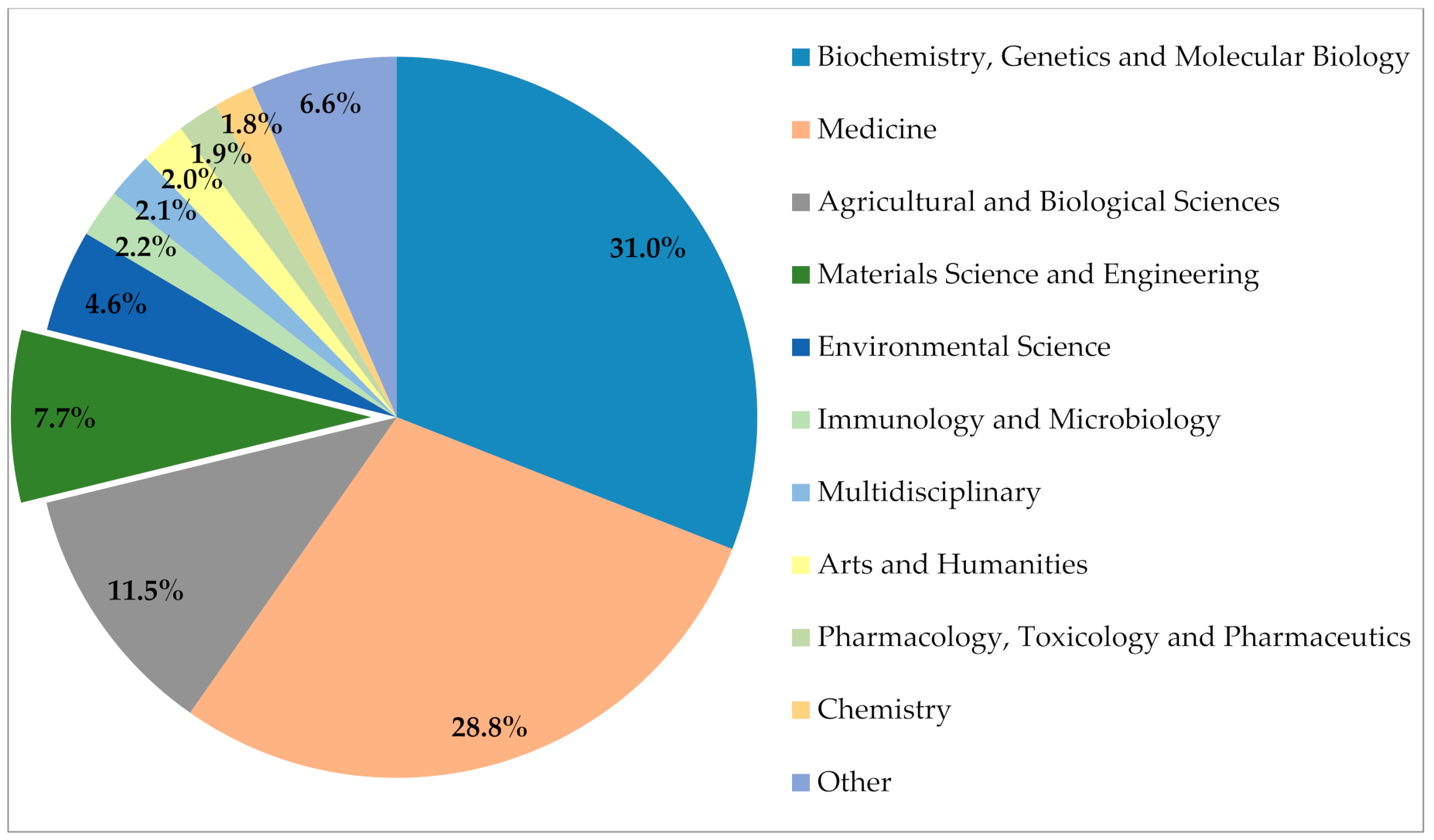
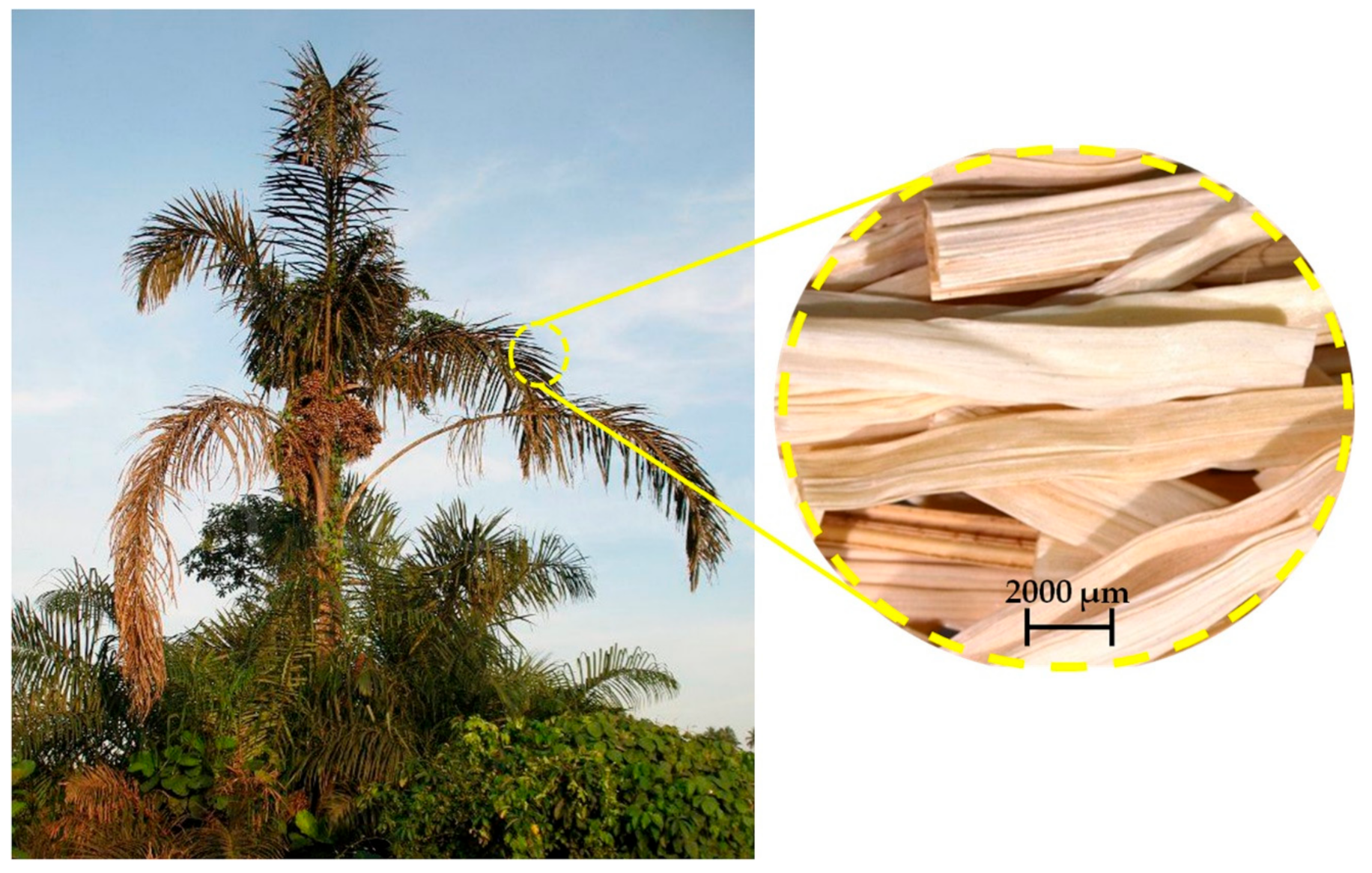
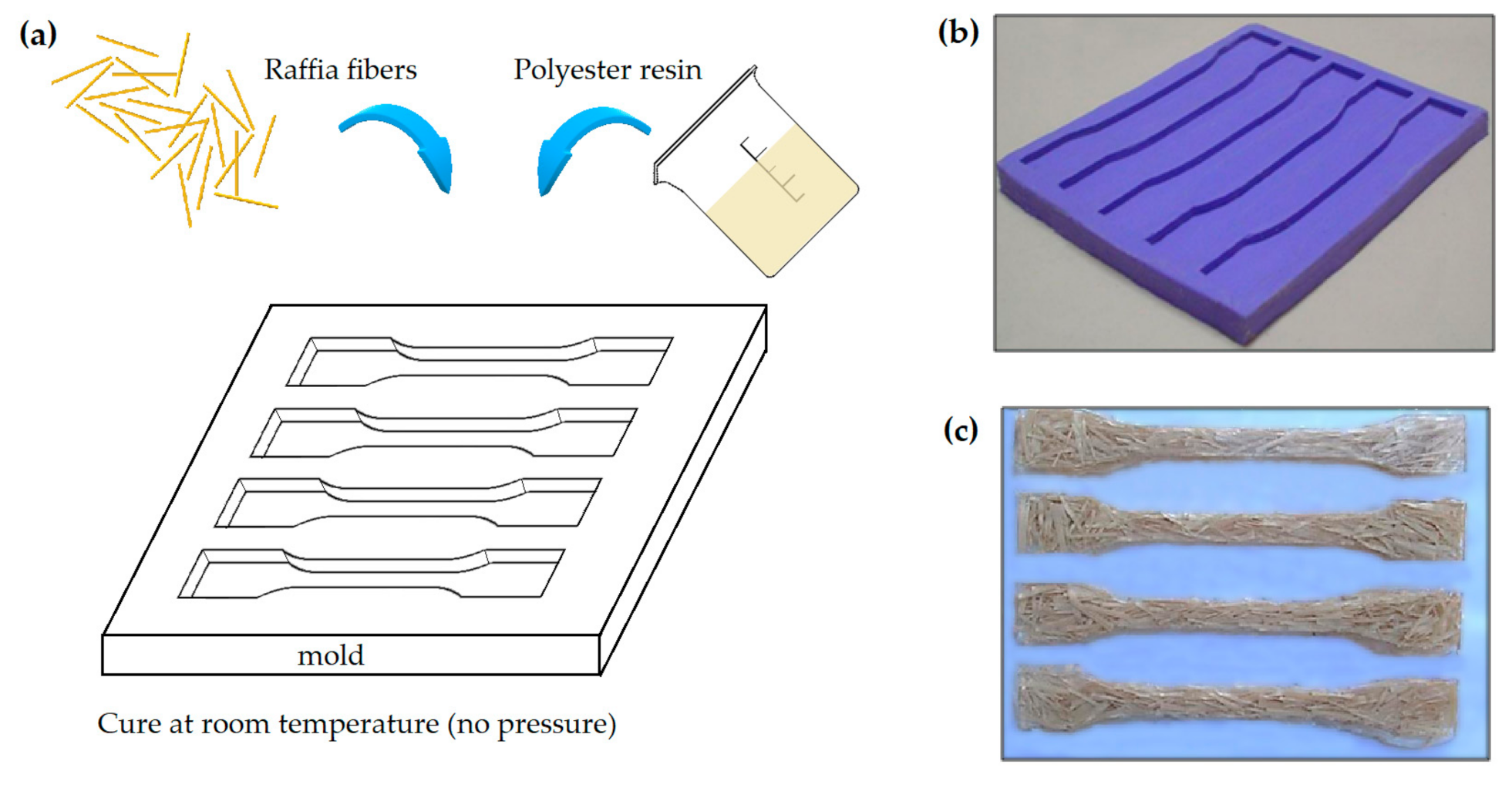
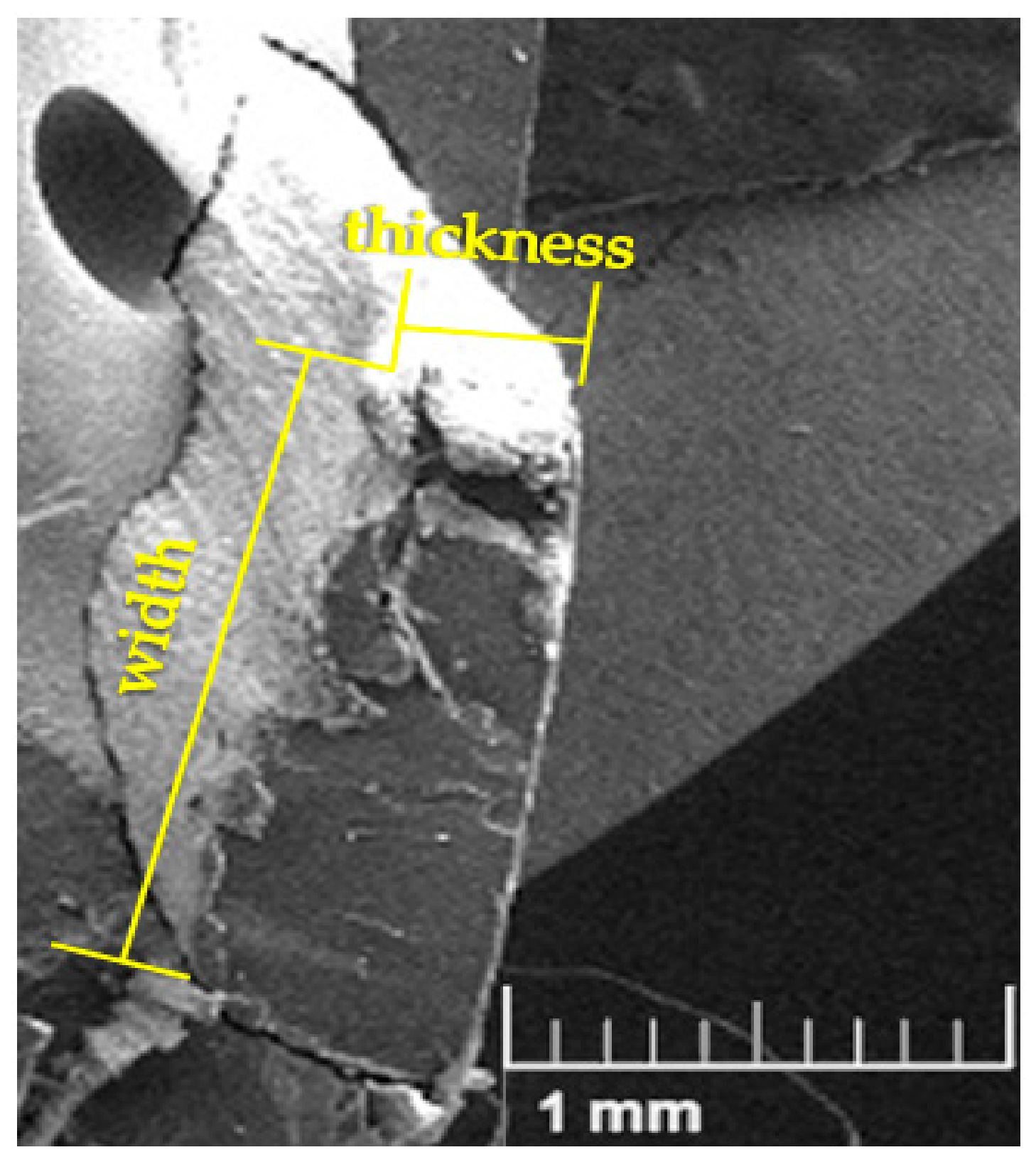
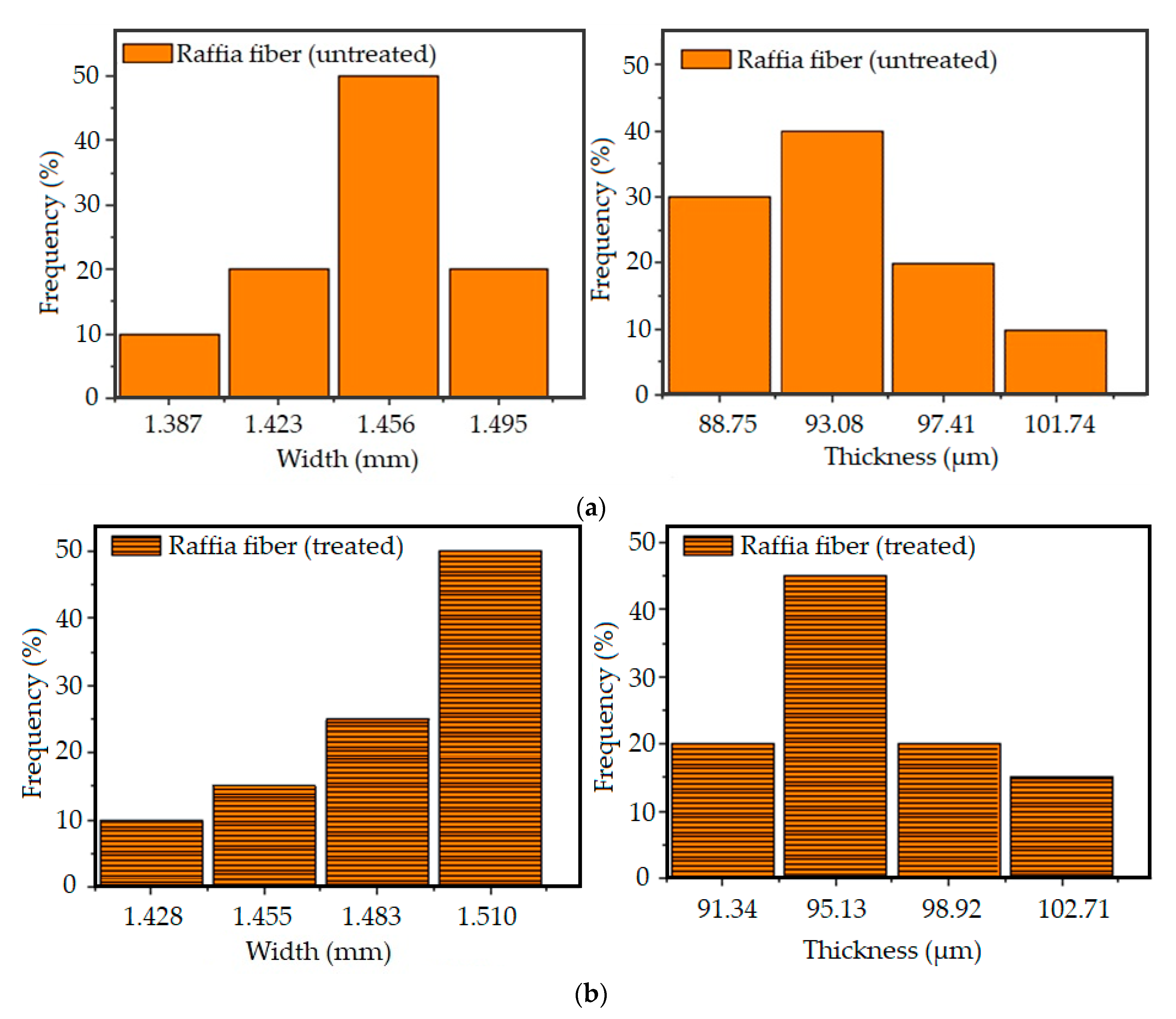
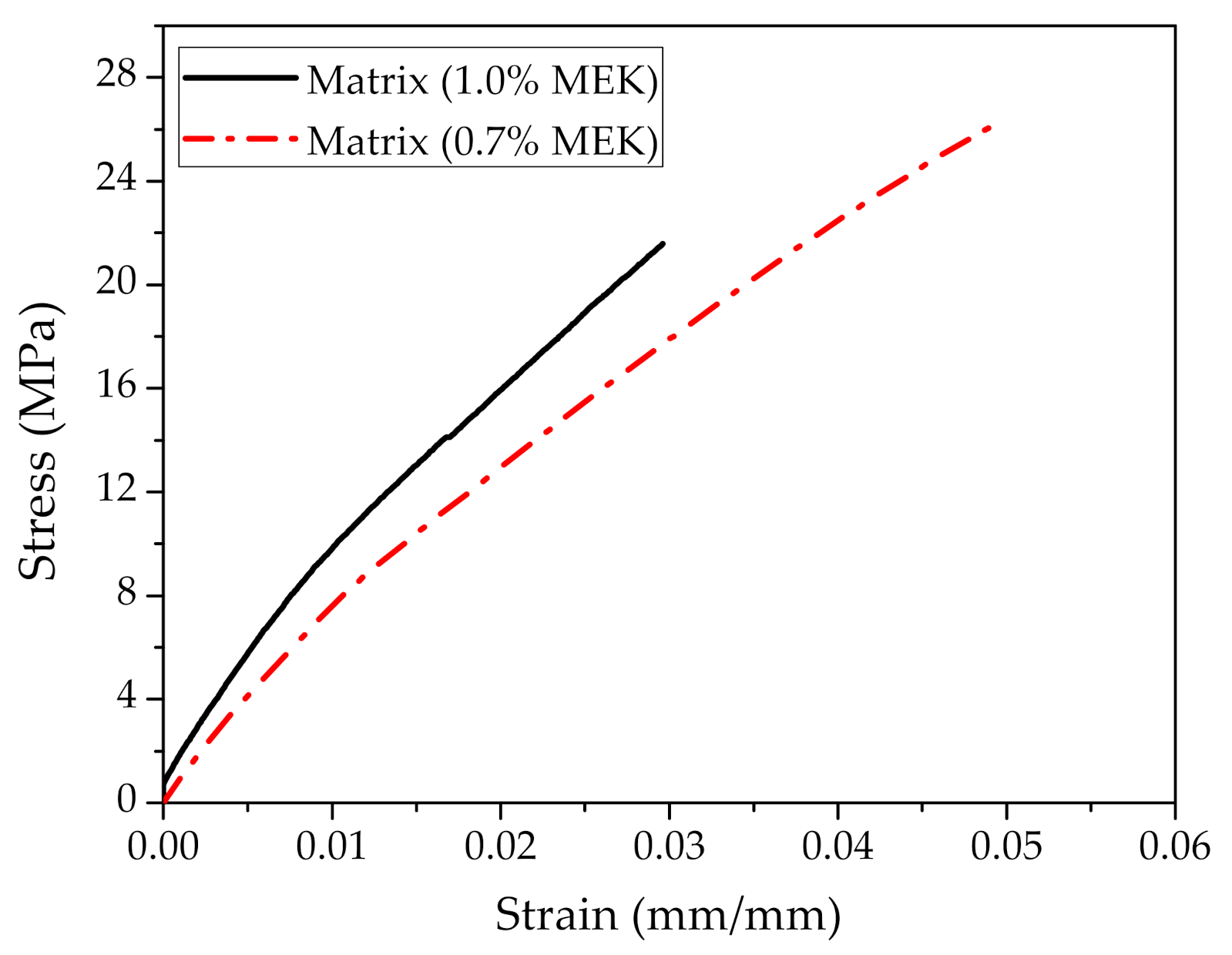

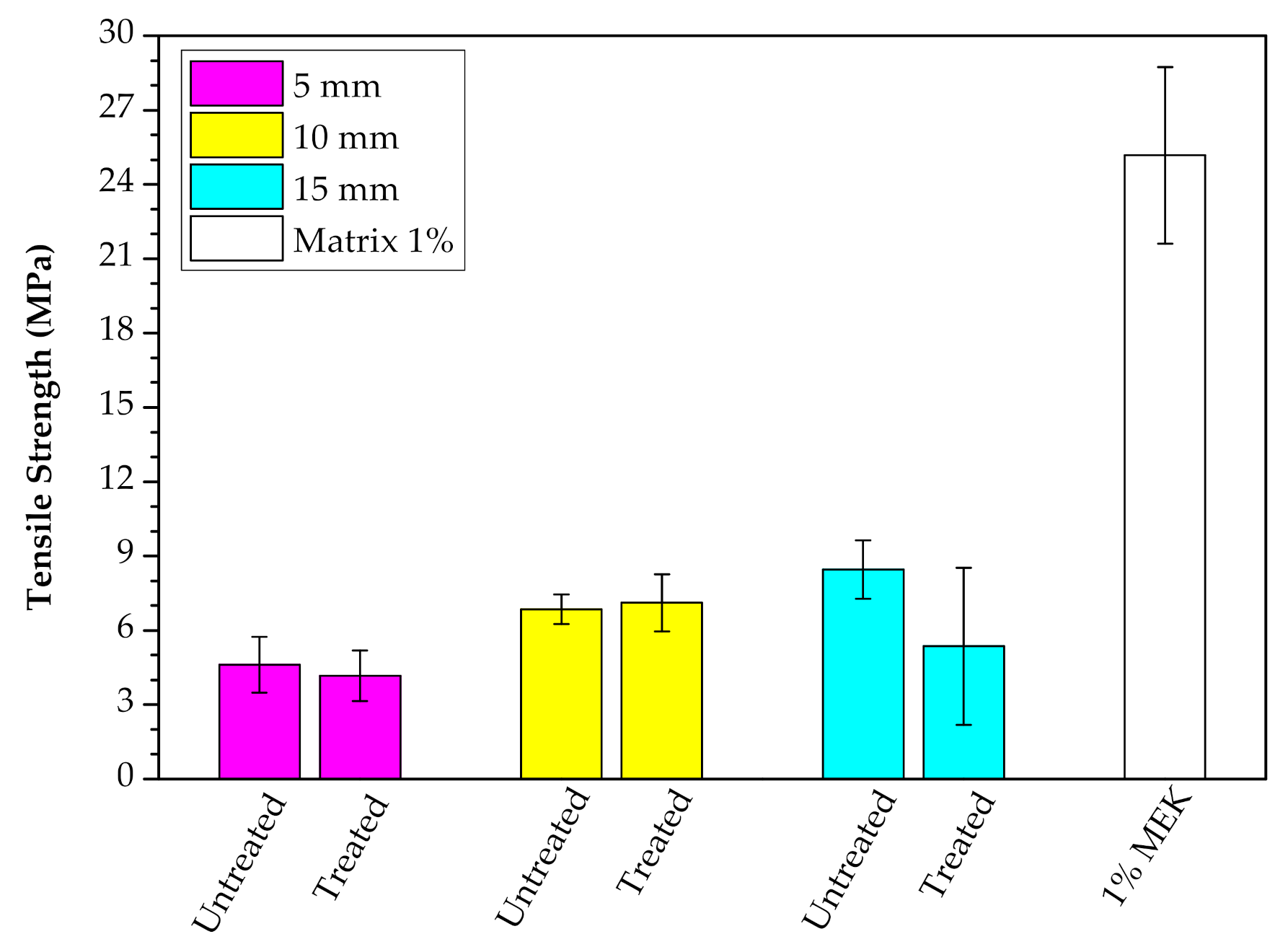




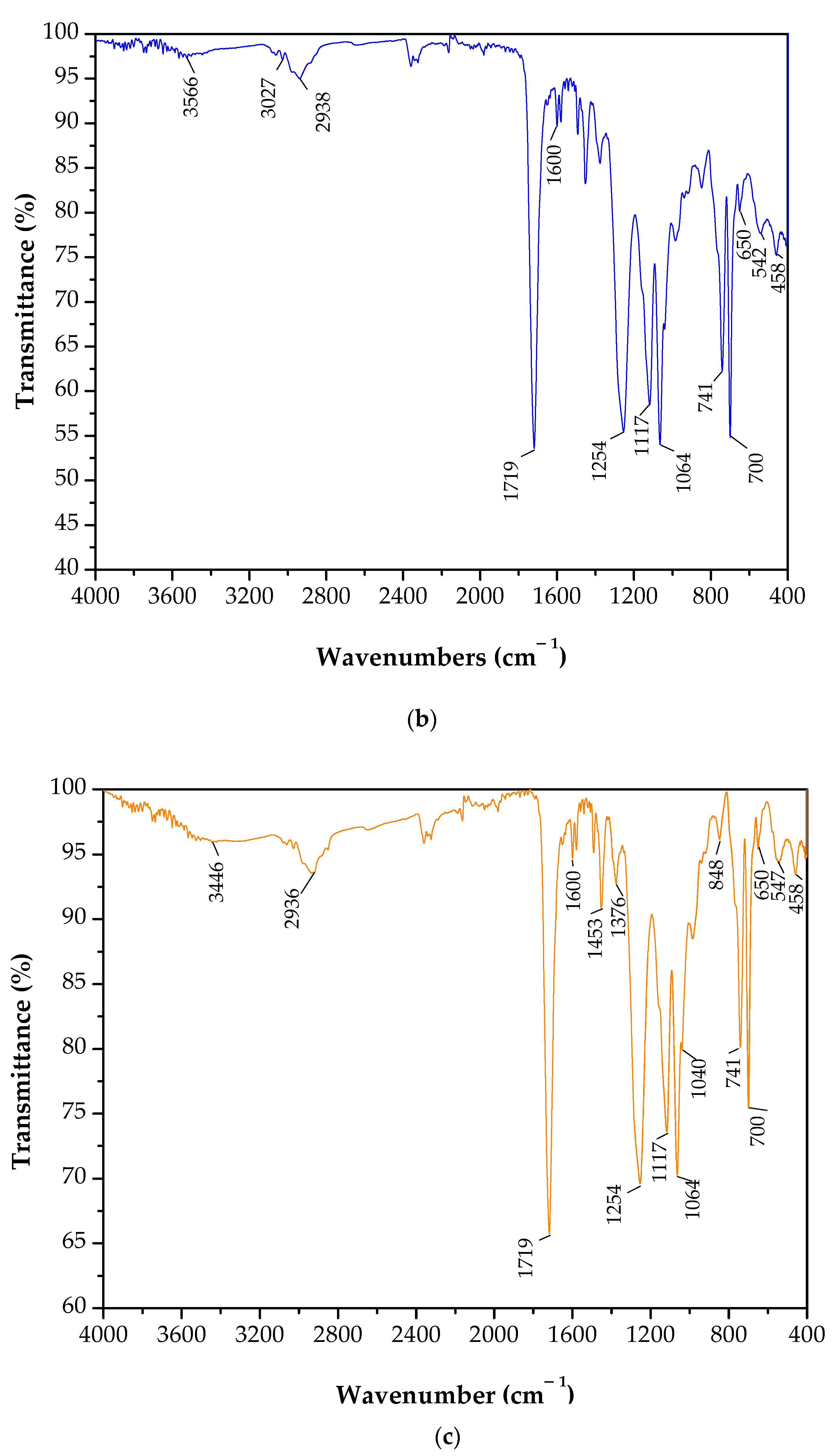
| Composite | Manufacturing Process | Condition | Fiber Content | Fiber Length (mm) | Tensile Strength (MPa) | Young’s Modulus | Ref. |
|---|---|---|---|---|---|---|---|
| (GPa) | |||||||
| Neat HDPE Matrix | Compression molding at 150 °C | Untreated | 0 wt% | NA * | 30 | 0.31 | [32] |
| HDPE/raffia fiber (powder) | 15 wt% | 18 | 0.33 | ||||
| 30 wt% | 15 | 0.42 | |||||
| 45 wt% | 13 | 0.60 | |||||
| 60 wt% | 10 | 0.79 | |||||
| Neat HDPE Matrix | Treated with MA-g-PE | 0 wt% | 29 | 0.31 | |||
| HDPE/raffia fiber (powder) | 15 wt% | 22 | 0.33 | ||||
| 30 wt% | 18 | 0.45 | |||||
| 45 wt% | 15 | 0.62 | |||||
| 60 wt% | 12 | 0.81 | |||||
| Neat Polyester Matrix | Vacuum infusion process | 53.3 kPa | 0 wt% | NA * | 34.36 | NI ** | [33] |
| Polyester/raffia fiber (aligned) | 53.3 kPa | 45 vol% | 23.59 ± 5.52 | 2.325 ± 0.180 | |||
| 101.3 kPa | 40 vol% | 22.97 ± 1.58 | 1.303 ± 0.090 | ||||
| Polyester/raffia fabric | 53.3 kPa | 35 vol% | 14.42 ± 0.90 | 1.010 ± 0.059 | |||
| 101.3 kPa | 43 vol% | 20.27 ± 1.88 | 0.913 ± 0.124 |
| Composite | Manufacturing Condition | Fiber Content | Fiber Length (mm) | Tensile Strength (MPa) | Young’s Modulus | Ref. | |
|---|---|---|---|---|---|---|---|
| (GPa) | |||||||
| Neat Polyester Matrix | Hand lay-up process | 1% MEK | 0 wt% | NA * | 25.18 ± 3.56 | 0.86 ± 0.25 | PW ** |
| Polyester/raffia fiber (randomly dispersed) | Untreated | ~10 wt% | 5 | 4.61 ± 1.12 | 1.03 ± 0.15 | ||
| Treated | 5 | 4.17 ± 1.02 | 1.15 ± 0.22 | ||||
| Untreated | 10 | 6.85 ± 0.59 | 1.07 ± 0.16 | ||||
| Treated | 10 | 7.12 ± 1.16 | 1.43 ± 0.11 | ||||
| Untreated | 15 | 8.46 ± 1.18 | 1.08 ± 0.29 | ||||
| Treated | 15 | 5.36 ± 3.17 | 1.02 ± 0.23 | ||||
| ANOVA | Source | Sum of Squares | Degrees of Freedom | Mean of Squares | F (Calculated) | F Critical | p-Value |
| Treatment | 0.889 | 6 | 0.148 | 3.405 | 2.445 | 0.012 | |
| Residual | 1.218 | 28 | 0.0435 | ||||
| Total | 2.107 | 34 | |||||
| Tukey Test | Degrees of Freedom (Total) | q (Tabled) | Mean of Squares (Residual) | HSD | |||
| 28 | 4.49 | 0.04 | 0.42 | ||||
| ANOVA | Source | Sum of Squares | Degrees of Freedom | Mean of Squares | F (Calculated) | F Critical | p-Value |
| Treatment | 1628.936 | 6 | 271.489 | 67.561 | 2.445 | 2.34 × 10−15 | |
| Residual | 112.515 | 28 | 4.018 | ||||
| Total | 1741.451 | 34 | |||||
| Tukey Test | Degrees of Freedom (Total) | q (Tabled) | Mean of Squares (Residual) | HSD | |||
| 28 | 4.49 | 4.018407 | 4.025208 | ||||
| Material | Wavenumber (cm−1) | Assignment |
|---|---|---|
| Raffia fiber | 3600–3000 | OH stretching |
| 2950–2840 | C–Hn stretching | |
| 1732 | C=O stretching | |
| 1510–1560 | ||
| 1650–1630 | C=C (Benzene stretching ring) | |
| 1462 | O–CH3 | |
| 1440–1400 | OH bending | |
| 1402 | CH bending | |
| 1244 | C–O–C stretching | |
| 1033 | C–O stretching and C–O deformation | |
| 700–400 | C–C stretching | |
| Raffia/polyester composite | 3600–3400 | O–H stretch |
| 3060 | Aliphatic C–H stretch | |
| 3026 | ||
| ~2936 | ||
| 1719 | C=O stretch | |
| 1600 | Aromatic ring stretch | |
| 1580 | ||
| 1492 | ||
| 1453 | CH3 asymmetrical bend | |
| 1376 | CH3 symmetrical bend | |
| 1254 | CH2 twist | |
| 1117 | C–O stretch |
Publisher’s Note: MDPI stays neutral with regard to jurisdictional claims in published maps and institutional affiliations. |
© 2020 by the authors. Licensee MDPI, Basel, Switzerland. This article is an open access article distributed under the terms and conditions of the Creative Commons Attribution (CC BY) license (http://creativecommons.org/licenses/by/4.0/).
Share and Cite
Oliveira Filho, E.G.d.; Luz, F.S.d.; Fujiyama, R.T.; Silva, A.C.R.d.; Candido, V.S.; Monteiro, S.N. Effect of Chemical Treatment and Length of Raffia Fiber (Raphia vinifera) on Mechanical Stiffening of Polyester Composites. Polymers 2020, 12, 2899. https://doi.org/10.3390/polym12122899
Oliveira Filho EGd, Luz FSd, Fujiyama RT, Silva ACRd, Candido VS, Monteiro SN. Effect of Chemical Treatment and Length of Raffia Fiber (Raphia vinifera) on Mechanical Stiffening of Polyester Composites. Polymers. 2020; 12(12):2899. https://doi.org/10.3390/polym12122899
Chicago/Turabian StyleOliveira Filho, Edwillson Gonçalves de, Fernanda Santos da Luz, Roberto Tetsuo Fujiyama, Alisson Clay Rios da Silva, Verônica Scarpini Candido, and Sergio Neves Monteiro. 2020. "Effect of Chemical Treatment and Length of Raffia Fiber (Raphia vinifera) on Mechanical Stiffening of Polyester Composites" Polymers 12, no. 12: 2899. https://doi.org/10.3390/polym12122899
APA StyleOliveira Filho, E. G. d., Luz, F. S. d., Fujiyama, R. T., Silva, A. C. R. d., Candido, V. S., & Monteiro, S. N. (2020). Effect of Chemical Treatment and Length of Raffia Fiber (Raphia vinifera) on Mechanical Stiffening of Polyester Composites. Polymers, 12(12), 2899. https://doi.org/10.3390/polym12122899







